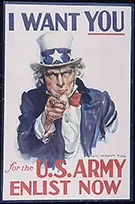War in the Pacific
As war raged in Europe, President Roosevelt continued to stick to his promise to keep the United States neutral. But when Japan attacked the United States, the country had to respond. The U.S. military fought the war on two fronts. One was Europe, but the other was the war in the Pacific.


The Attack on Pearl Harbor. On December 7, 1941, Japanese bombers attacked a navy base in Pearl Harbor, Hawaii. The attack occurred just after dawn. The Japanese had an aircraft carrier and launched more than 300 planes. The attack lasted only an hour and a half, but was very destructive. The U.S. lost eight battleships, three cruisers and three destroyers.
The attack killed more than 2,000 and injured another 1,000. The Japanese lost only 26 airplanes. While some were attacking Pearl Harbor, others attacked Guam Wake Island and the Philippines. Japan intended to destroy the American fleet and keep them from fighting in the Pacific. It had the opposite effect. The day after the attack, President Roosevelt declared war on Japan and Germany. Working very hard, soldiers repaired six of the battleships and they went on to fight in the war.

The Bataan Death March. In April 1942, American and Philippine prisoners of war began the journey from the Bataan Peninsula to Camp O’Donnel in the middle of the Philippines. More than 80,000 men began the trek. As they walked, the prisoners had little food or water. They walked many miles every day and slept on the ground.
Many men became sick and Japanese soldiers killed those who fell. On the last part of their journey, the soldiers loaded up to 100 men into closed railway cars. The men sweat in the tropical heat and many died. By the time they reached the camp, more than 25,000 men were dead.

The Battle of Midway. After their victory in Pearl Harbor, the Japanese thought the United States bases were easy to destroy. But they were wrong. The Japanese planned to lure the American fleet into a trap on a tiny island called the Midway Atoll. But, the Japanese didn’t know that U. S. Code breakers had figured out the Japanese secret codes.
So they knew that it was a trap. The U.S. sent several ships into the trap, but kept many other battleships nearby. When the Japanese attacked, the larger U.S. force surrounded the Japanese ships and sank their battleships. This was a turning point in the war in the Pacific.

Navajo Code Talkers. Secret codes were a very important part of warfare. Speaking and writing in code allowed soldiers to send messages across long distances without the enemy understanding. Breaking the codes of Japanese and German spies was an important job. But it was just as important to create a code that the enemy couldn’t crack. Phillip Johnston was too old to be a soldier, but he wanted to help. He grew up speaking Navajo and knew how difficult the language was.
He brought several Navajo soldiers to the military and showed how the language was perfect for secret codes. First of all, it had several unique sounds found no other place on earth. Secondly, words can have up to four different meanings depending on inflection. Finally, no one outside of North America knew the language. The U.S. asked the Navajo people to help them and they did. The Navajo Code Talkers became a vital part of winning the war in the Pacific and used the only secret code that was never cracked.

The Bombing of Nagasaki and Hiroshima. After several months of bombing, Japan still refused to surrender. Bombers destroyed up to 97% of some of the major cities. Thousands of people were dying every day. Japan is an island, and its shape made it difficult or impossible for a large-scale military assault. The Allies discussed the best way to end the war. The United States offered a new type of bomb. This atomic bomb could cause much more damage than the traditional bombs dropped by airplanes.
Before dropping the bomb, The U.S. military dropped leaflets by air, warning the people of the bombing. The first bomb detonated on the city of Hiroshima on August 6, 1945. Japan still refused to surrender. The U.S. dropped the second bomb on Nagasaki three days later on August 9, 1945. Japan surrendered to the Allied forces five days later on August 14, 1945, ending the Second World War.



